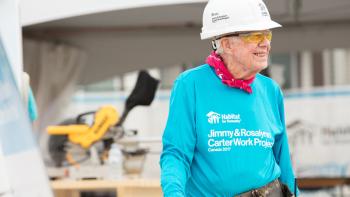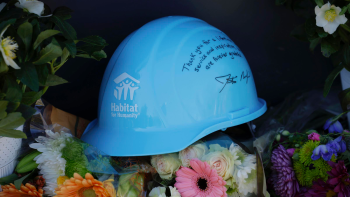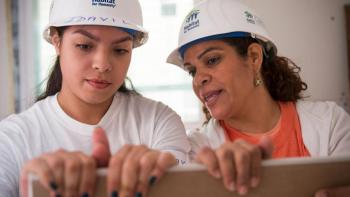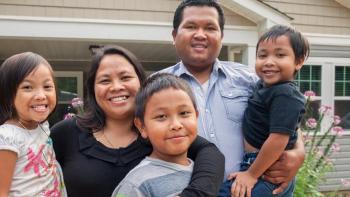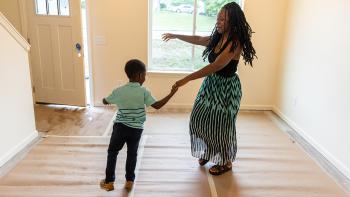A man and his mission
President Carter called Habitat a “singular, divine concept that has opened a vision to me.”
In 1991, President Carter called Habitat for Humanity “a singular, divine concept that has opened a vision to me.”
That vision — a world of housebuilding people helping each other and themselves — took him to build sites across the United States and around the world.
For more than three decades, President and Mrs. Carter worked alongside those who had also glimpsed the possibility of a world where everyone has a decent place to live.

A man and his mission

Habitat for Humanity mourns the death of former U.S. President Jimmy Carter
Hábitat para la Humanidad lamenta el deceso del expresidente de los Estados Unidos Jimmy Carter
Ayuda en vivienda de Hábitat para la Humanidad
Como organización global de vivienda, la visión de Hábitat es un mundo donde cada persona tenga un lugar digno para vivir.
Advancing Black Homeownership exhibit
Leveraging the power of storytelling and art, the exhibit aims to catalyze a movement to reduce the racial wealth gap by inviting visitors to experience and visualize the multitude of factors that contribute to housing inequities in the U.S.
Pasos para ser propietarios de una vivienda
Hábitat acompaña a cada familia en el difícil camino de ser propietarios de vivienda. Desde asistir a cursos para propietarios, hasta ayudar a construir sus propias viviendas o las de otras familias, cada paso empodera a los futuros propietarios y les ayuda a fomentar las habilidades que necesitan para triunfar.
Hábitat acompaña a cada familia en el difícil camino de ser propietarios de vivienda. Desde asistir a cursos para propietarios, hasta ayudar a construir sus propias viviendas o las de otras familias, cada paso empodera a los futuros propietarios y les ayuda a fomentar las habilidades que necesitan para triunfar.
Gestionamos el proceso de selección de propietarios a nivel local, desde la consulta inicial hasta el cierre.
¿Le interesa saber cómo convertirse en propietario de una vivienda Hábitat? Siga los pasos siguientes.
Ir a:
Paso 1: Consultar | Paso 2: Solicitar | Paso 3: Entrevistar | Paso 4: Aprobar | Paso 5: Participar | Paso 6: Cerrar | Paso 7: Mudarse
Paso 1: Consultar
Las afiliados locales de Hábitat organizan sesiones informativas en las que los posibles propietarios pueden informarse sobre su programa de adquisición de viviendas. Así, los posibles futuros propietarios tendrán tiempo de hacer preguntas y establecer contactos.
“En la orientación me explicaron todo, desde cómo presentar la solicitud hasta cómo funciona el proceso”, dice Maximino, propietario de una vivienda mediante el afiliado de Hábitat Evergreen. “Nos lo explicaron todo y respondieron a todas nuestras preguntas”.
Contacte a su afiliado de Hábitat local para informarse sobre las sesiones presenciales o en línea.
Para ayudar a las personas que no hablan inglés a hacer realidad su sueño de ser propietarios de una vivienda, los afiliados pueden contratar a un traductor durante el proceso de adquisición de vivienda.
Paso 2: Solicitar
Si una familia considera que el programa de propietarios de viviendas Hábitat es el que desea, debe presentar la solicitud localmente, durante un período de inscripción abierta.
El personal de Hábitat trabaja con los solicitantes para que presenten la documentación (recibos salariales u otros comprobantes de ingresos, documentación sobre vivienda subestándar, entre otros).
El personal local de Hábitat revisa con cuidado cada solicitud según los siguientes criterios:
● Necesidad de vivienda. Los futuros propietarios deben demostrar que necesitan una vivienda segura y asequible.
● Voluntad de aliarse. Una vez seleccionados, los futuros propietarios deben colaborar con Hábitat durante todo el proceso.
● Capacidad para pagar una hipoteca asequible. Los futuros propietarios de vivienda también deben poder y querer pagar una hipoteca asequible. Los pagos de las hipotecas de Hábitat se reinvierten en la comunidad para ayudar a construir más viviendas Hábitat.
Más información sobre nuestros requisitos para propietarios.
Paso 3: Entrevistar
El siguiente paso es una entrevista en persona.
El personal o los voluntarios de Hábitat realizan una visita al hogar para escuchar más sobre el deseo de ser futuros propietarios en alianza con Hábitat, conocer a la familia y conocer su situación de vivienda actual y sus necesidades de vivienda futuras.
Paso 4: Aprobar
El personal y los voluntarios de Hábitat en la localidad revisan con cuidado el paquete de solicitud de cada familia y presentan sus recomendaciones a la junta directiva local.
En la mayoría de las oficinas de Hábitat locales, la junta toma la decisión final.
Paso 5: Participar
Una vez seleccionada, la familia está oficialmente en camino de convertirse en propietaria de una vivienda.
Al principio del proceso, Hábitat ofrece una mezcla de aprendizaje práctico y en el aula, a través de clases para futuros propietarios de vivienda. Ya sean presupuestos, pequeñas reparaciones en el hogar, paisajismo o planificación de la jubilación, cada curso tiene como objetivo ayudar a los propietarios a alcanzar el éxito en sus nuevas viviendas, mientras crean lazos con otros futuros propietarios de viviendas Hábitat.
Cada familia que se asocia con Hábitat completa un cierto número de horas de trabajo antes del día de la mudanza. A menudo, miembros adultos de la familia directa o ampliada (así como voluntarios, compañeros de trabajo o amigos) contribuyen con horas de ayuda mutua.
Los participantes pueden acumular horas de diversas maneras, como trabajando en una obra de construcción de Hábitat (propia o ajena), ayudando en una tienda ReStore de Hábitat o colaborando en tareas administrativas en la oficina de Hábitat.
Muchos afiliados de Hábitat también ofrecen soluciones creativas para que los niños y las niñas puedan participar en el proceso y acumular horas de ayuda mutua. Por ejemplo, el afiliado de Hábitat Chipola, en el estado de Florida, otorga una hora de ayuda mutua por cada calificación sobresaliente que los niños o las niñas obtengan en la escuela.
Paso 6: Cerrar
Luego, los futuros propietarios de vivienda completan la documentación para obtener la hipoteca. Hábitat ofrece a los futuros propietarios de vivienda una hipoteca asequible con pagos mensuales compatibles con sus ingresos familiares. Los pagos hipotecarios realizados por los propietarios de viviendas Hábitat ayudan a construir viviendas más asequibles.
Paso 7: Mudarse
Una vez firmados todos los formularios y finalizadas todas las obras, ¡es hora de celebrar!
Amigos, familiares, miembros del personal y voluntariado de Hábitat que trabajaron junto a la familia, se reúnen para dedicar la vivienda. Es la primera de muchas ocasiones felices que se celebrarán en el nuevo hogar.
Ahora, con la estabilidad de una vivienda que ayudaron a construir, las familias tienen más tiempo y recursos para invertir en otras áreas de su vida. Pueden invertir más en salud y educación familiar. Muchos propietarios de viviendas Hábitat continúan sus estudios secundarios y alcanzan sus objetivos profesionales. Otros encuentran la manera de seguir retribuyendo a la comunidad que les acogió.
Sean cuales sean los sueños de una familia, ser propietarios de una vivienda asequible les libera de cargas (estrés, inestabilidad financiera y otras) que se interponen en su camino.
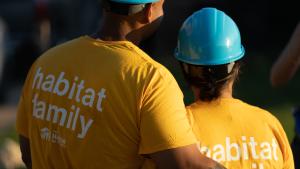
Timothy Phillips
Chief Legal Officer
Craig Molyneaux
Chief Financial and Administration Officer
A bright and healthy future ahead
Yulisa and Guillermo yearn for a home where their son, Cesar, will have the freedom to play and grow. Now the couple is building an affordable Habitat home with the help of Wells Fargo volunteers and the Wells Fargo Foundation.
Yulisa and Guillermo dream of the day when their son, Cesar, has a room that brings him happiness and comfort. That day is coming soon, once they move into their future home at Habitat for Humanity East Bay/Silicon Valley’s Esperanza Place.
Yulisa works as a vice president of a labor union, while her partner, Guillermo, stays home full time to care for Cesar.
“Cesar has autism, and there are sensorial things that he needs that we don’t have the space here for in our apartment,” Yulisa says.
Guillermo plans to mount, for example, on the ceiling of Cesar’s new room, a hammock-like apparatus whose pendulum motion will help the 12-year-old center himself — a customization that is not possible to implement in their rental.
“It’s something that’s going to make him feel better and have him be able to thrive in the new space,” Guillermo says. “And, for us, it’s just peace of mind knowing that he’s happy.”
Homeownership within reach
As Bay Area residents, Yulisa and Guillermo were accustomed to continually skyrocketing rental prices; purchasing a home affordably seemed impossible until Habitat. “We’re looking forward to the security of not having to depend on our landlord’s decision to raise the rent and then us being pushed out,” Yulisa says. “We’re not going to have to worry about being displaced.”
Yulisa and Guillermo also look forward to being in an environment where neighbors look out for each other. “Building community is going to be really important to make sure that Cesar has some sense of community that he doesn’t have now, which is going to help him flourish,” Yulisa says.
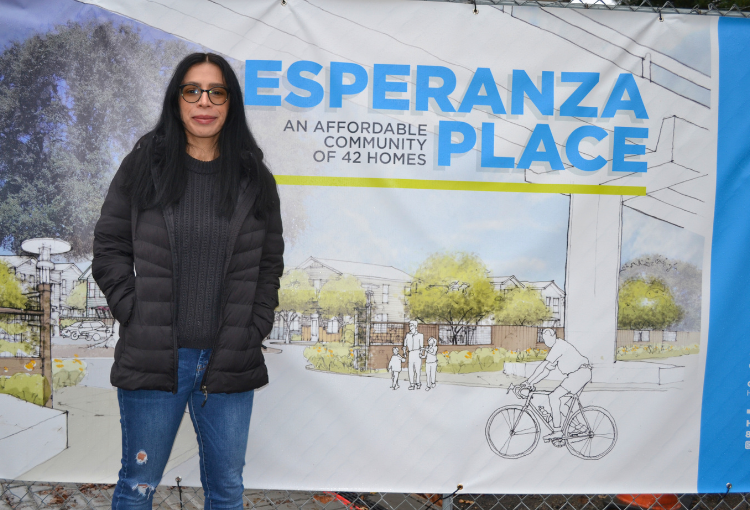
Yulisa stands in front of a sign for Esperanza Place, a community where her family and other future Habitat homeowners are building a safe and affordable place to call home.
Laying the foundation for a resilient neighborhood
Yulisa and Guillermo began connecting with their future neighbors on the build sites of their and other Habitat homes at Esperanza Place. During those builds, the couple prioritized forming relationships with their future neighbors.
“When you look at who Yulisa and Guillermo are, their goals for their family’s future and what they want to give to others — they’re just delightful and wonderful human beings,” says Janice Jensen, Habitat East Bay/Silicon Valley CEO. “They truly understand what it means to build community.”
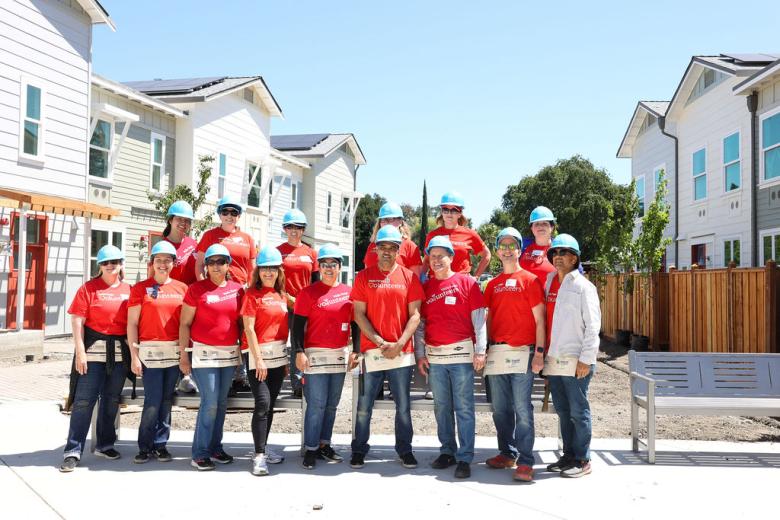
Wells Fargo employees volunteered alongside future Habitat homeowners to help build affordable homes at Esperanza Place. (Photo credit: Jodi Foucher Photography)
In addition to new neighbors, Yulisa and Guillermo also worked alongside Wells Fargo volunteers who helped build homes in the development. Anne Woo-Sam, a Wells Fargo product manager, pitched in on projects like landscaping and painting.
“It’s pretty incredible that as a volunteer you can help reduce the cost of a home so that it becomes affordable for families who work in the community. Commuting far to work means having to spend a lot of time away from their families,” Anne says. “But living close to where they work means they can take that time to create memories.”
In addition to volunteer support, funding from the Wells Fargo Foundation helped make Yulisa and Guillermo’s home more affordable by offsetting the construction cost of their home. Since 2015, Wells Fargo and the Wells Fargo Foundation have donated more than US$102 million to the Habitat network in support of affordable and sustainable housing.
A framework for joy and wellbeing
Once they move into their Habitat home, Yulisa and Guillermo look forward to making precious new memories with Cesar in a space where he can be more comfortable. “That’s what we’re trying to do — set up an environment that will be more conducive for him to be connected to us,” Guillermo says.
Yulisa also says their new Habitat home will give her family the financial freedom to build savings that will help support Cesar’s care well into adulthood. “We haven’t been able to, and saving is important to us,” she says.
(Photo credit for top photo: Jodi Foucher Photography)

A bright and healthy future ahead










